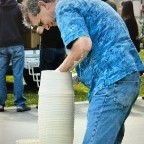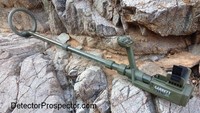
I slowly worked my way up the wash, swinging my new Garrett ATX pulse induction metal detector from side to side. I was on bedrock so hunting the best I could, taking extreme care to cover every inch of ground, and keeping the hot spot of the coil as close to the bedrock as possible. I took my time, and moved a rock or two when they kept me from getting the coil as close to the ground as I wanted to. I concentrated on the bottom of the wash but scanned areas along the side that looked inviting.
Hours of careful work had produced a handful of targets. Bullets, shell casings, nails, and bits of flat steel. I was new to the area, relying on friends to point me in the right direction. One of those friends had found a couple nuggets earlier when we were both farther down the gully, but he had wandered off somewhere up ahead of me. I worked along a bend in the wash, where the sand covering the bedrock was deeper. There was exposed hardpan material along the inner corner so I worked along that, digging another nail. Then I saw a bit of bedrock peeking out of the sand, and scanned it with the coil. Another loud signal, probably another piece of steel. I gouged out some soil and fractured bedrock, and out popped a gold nugget! My first Arizona gold, and my first gold nugget with the new Garrett ATX. I was elated and got out my camera to record the event.
The nugget was quite flat, more like a large flake of gold, and later weighed in at 0.7 grams. My expectations for this little trip had been about zero since I was absolutely new to the area and the detector, so I was very happy. I picked up the detector and gave it a couple more swings, and got another signal! This time I was pretty sure it was gold since it was less than two feet away from the first signal. I went ahead and exposed the bedrock crevice and carefully scraped and blew the material away until a small nugget was exposed to human eyes for the very first time.
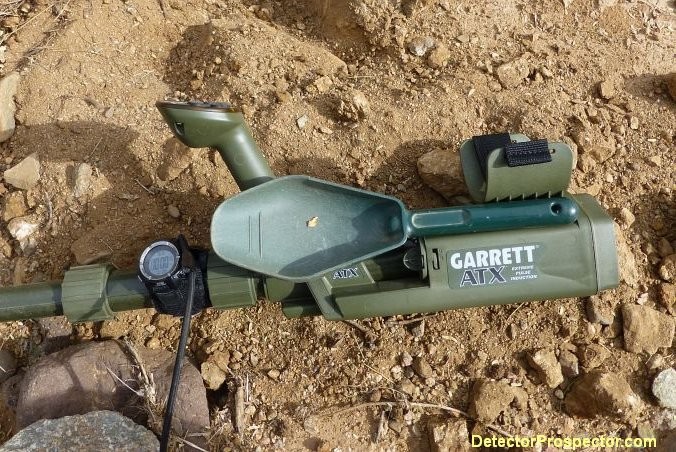
My first Arizona gold nugget and first found with the new Garrett ATX
This nugget was even smaller than the first, weighing in at 0.39 grams. Again, a clean solid signal, no problem finding this little nugget. Now I had two nuggets in my bottle, and I gave the spot a good go looking for a third, but that was it for that stretch of creek. I continued my way up the wash, very happy with the day and the new Garrett ATX.
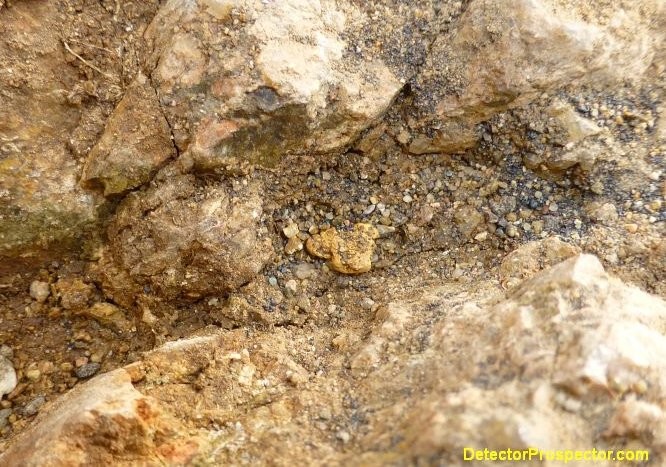
Small 0.4 gram gold nugget in crevice - second found with new Garrett ATX
I had recently acquired the detector but I was initially too busy to get out and go prospecting with it. I did a bunch of short day trips coin and jewelry detecting with the machine and posted my results in an earlier article. I finally got the time to go prospecting with the ATX and my first outing was a short day trip to an old hydraulic mine in the northern Sierras. With the drive there and back I only had a short amount of time detecting, and unfortunately did not find any gold. I did learn a few things however. First and foremost was that I forgot to bring along the sling that comes with the ATX. I went ahead and used the detector without, and by the end of the day decided a sling or harness is mandatory for using the ATX for more than a couple hours. Prospecting combines long hours with rough terrain and so is more physically demanding than most types of metal detecting. My forearm and hand was sore at the end of the day from using the ATX.
More detecting to come but lets pause and talk about setting up the ATX for gold detecting. The ATX is ridiculously easy to tune up for nugget detecting. A good way to start if unsure of the detectors settings is to hold the RETUNE/PINPOINT button down while turning the detector on. This resets everything to factory default. The ATX factory default settings are:
Mode: Motion
Discrimination: Zero discrimination (1st LED)
Sensitivity: 10
Threshold: 7
Volume: 10
Ground Balance: Neutral
Ground Track: OFF
With this starting point in the locations I have hunted so far I have been able to adjust the Sensitivity all the way up to the maximum setting of 13. In most locations it is not needed but as a matter of habit I then push the FREQ SCAN and let the ATX cycle for a minute to find the quietest operating frequency. If I intend to use my Garrett Pro Pointer I have it turned on and a couple feet away while the frequency scan is performed to help eliminate interference from the pinpointer when I am using it. If I have a buddy hunting nearby they also should be turned on an operating maybe 50 feet away while the scan is performed, to help eliminate any possible interference from their detector. I want to point out that I was in very close proximity to some high tension power lines on this trip. The ATX was able to tune out the electrical interference from these lines with no problem unless directly under them. I would be able to work there but only by backing the sensitivity down quite a bit.
I normally do a manual ground balance. Just push and release the SHIFT button, insuring that the red LED indicator comes on. This activates all the control secondary functions. Then press and hold the GND BAL button while pumping the coil up and down about 6 inches over the ground. The ground will initially signal (unless it is neutral ground) with louder signals indicating more mineralized ground. Then within 3-7 seconds the detector should go quiet, indicating that the ground balance is complete. Release the button. Finally, I adjust the threshold to be a barely discernible tone. Running without headphones and using the built in speaker I find this to be a notch above the factory default of 7 and so set my ATX at threshold 8. Now I am ready to go nugget detecting.
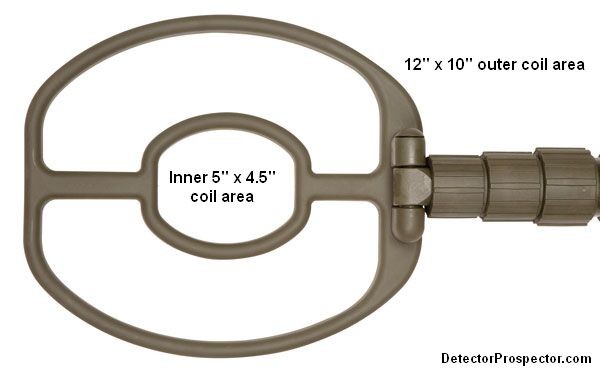
Garrett ATX standard 12" x 10" DD search coil
I have an 8" round mono coil for the Garrett ATX that I think may be a good choice for nugget detecting but so far I have used the 12" x 10" modified DD coil that comes with the detector. I did this on purpose to be able to report to people on how the coil that comes with the detector performs. I learned a couple very important things. First is that small nuggets give varying tone responses depending just where they are under the coil. A small nugget dead center under the coil will usually give the normal high/low audio indicating a low conductive target. That same nugget moved forward of center under the section of coil connecting the nose to the center coil circle will reverse in signal to low/high. In order to get consistent tones small targets must be centered under the coil. Most importantly, the signal on small nuggets weighing under a gram is greatly enhanced under the inner 5" x 4.5" coil area. Although this is a DD coil it is a new modified design with the inner windings split apart to form the small inner coil area. In some respects it acts like two coils; a large 12" x 10" outer coil and small 5" x 4.5" inner coil.
My advice when hunting for small gold nuggets using the stock coil is to focus on and treat the small 5" inner coil as the only coil on the ATX. Larger nuggets will take care of themselves and signal anywhere under the 12" x 10" coil though as a DD coil the field is centered more down the middle of the coil. The ability to find small nuggets is enhanced in the center coil area with best depth and tone response dead center in the middle of the coil. If hunting for larger than gram nuggets you can focus more on using the overall coil but again, if chasing small gold, focus your attention and act as if you have a 5" coil on the detector.
My air tests with the 8" mono reveal that it has the even coil response I would expect of a mono coil and overall better depth on half gram nuggets than what is in effect the 5" inner coil that comes stock with the ATX. There may be a situation where the 5" inner coil meets the 8" mono in performance on the smallest nuggets weighing only a grain or two but I have not had time yet to explore this possibility. The bottom line is that the ATX comes stock with what acts like two coils, a 12" coil for most targets and a 5" inner coil for tiny targets. The obvious caveat is that you are swinging the weight of a 12" coil when you use it as a 5" coil. And as I found, it is impossible to get the small 5" inner coil into pockets in bedrock or even laterally up against a large rock or the base of a bush. The outer 12" x 10" ring acts as a barrier. So I do very much recommend that for hunting small gold a prospector seriously consider adding the round 8" mono coil as an option. I plan on using it for future hunts now that I have experience with the standard coil. The good news for many people, especially those that might hunt for nuggets rarely, is that the ATX 12" x 10" DD coil is very versatile and can serve well finding small gold nuggets without investing more money in a specialty coil.
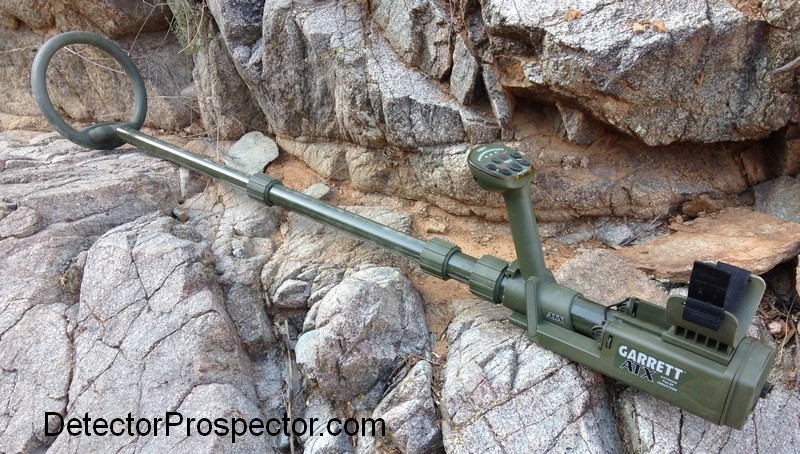
Garrett ATX with 8" mono coil
I have lots of questions regarding the stock coil versus the 8" mono as far as how the two differ in handling mineralized ground, hot rocks, electrical interference, and depth on both large and small gold nuggets. I have a lot left to learn still about the Garrett ATX but I will pass on what I learn as I learn it.
The stock coil is marginally sensitive to false signals when contacting rocks. This is a bit odd since it is an epoxy filled coil so in theory the coil windings cannot move to produce false signals when bumped. The signals do not occur consistently or often but in my case at least happened most often when the coil would catch a rock on the surface and roll the rock under the coil. It is possible that the coil cable, even though protected by being enclosed in the lower shaft assembly, is jiggling enough to produce the signals. Another area for more investigation. The open design of the stock coil provides lots of edges to catch on rocks and stubble. A solid bottom scuff cover would be a nice option although they have a tendency to collect debris. This would allow the coil to slide better on the ground, possibly reducing the false signals, and more importantly keeping the coil from hanging up. If I had a wish it would be for a solid elliptical mono for nugget detecting, perhaps a 10" x 6" more or less. The 8" mono with solid coil cover will be nice.
This all leads right back around again to arm strain. The ATX is a heavy metal detector at 6.9 lbs. Add to this the need to use carefully control the 12" coil while prospecting. I found the combination of the need to keep the coil close to the ground while avoiding having it false by rolling rocks under the coil or catch an edge on an obstruction to be very wearing. I have to constantly tweak, twist, and twiddle the position of the coil in relation to the ground. This is normal in nugget detecting. In my opinion superb coil control is one of the secrets that separates the pros from the amateurs. The ATX is simply too heavy for 8 - 12 hours of this activity daily, especially for days in a row. At least for this guy! There are no doubt some people for whom it will not be an issue. I have decided that for my nugget detecting with the ATX additional support is necessary.
The included sling is much better than I thought it would be. It hooks over one arm, drapes across the back of the neck, and drops over the opposite shoulder to support the ATX. I found the easiest option is to just slip the elastic loop at the end of the sling over the control pod and onto the handle of the ATX. With the rod length kept short it balances perfectly there, and is very easy to just slip back off when putting the detector down to dig. The only improvement I can see would be for extra padding under the area directly back of the neck where the sling splits to go around the arm. There is no padding there and it tends to dig a bit if used long hours with just a thin shirt.
I decided to go one step further however. I recently acquired a Minelab Pro-Swing 45 harness and bungee system. This new harness incorporates a plastic strut that transfers weight from the shoulder to the waist belt. This not only relieves shoulder strain but helps keep the harness belt from creeping up your back as the front of the harness is pulled down. I have other heavy detectors I thought might benefit from using this harness and so it was a happy coincidence I already had one on hand to use with the Garrett ATX.
The Pro-Swing comes with a clip and Velcro wrap you can position wherever you like on the detector. I keep as much weight as possible to the rear by keeping the shaft short, basically just using the lighter two lower sections and about 3 inches of the uppermost rod section. This makes a nice little spot between the upper rod locking rings to attach the clip. The bungee can be disconnected at both the detector end of the bungee by slipping it off the clip or off at the shoulder also, which I found I preferred. I now buy cheap LCD watches for all my detectors and leave on them since I normally do not wear a watch myself. I can keep track of time or set alarms for myself to tell me it is quitting time. I put my ATX watch on at the same location. Total aside here but every detector with a LCD readout should have a built in clock and alarm. Time flies when I am detecting!
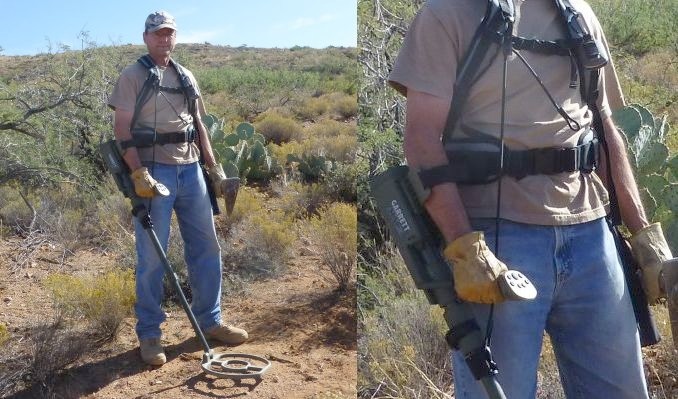
Garrett ATX and Minelab Pro-Swing 45 harness
It took a bit of fiddling to get the detector set right, which is very easy. Just take a guess at the correct bungee length and go detecting. It takes just a second to adjust the length by pulling down on the bungee end to release and pulling up again to lock. You feel very quickly if the setting is too long or too short and just adjust up a bit to get it right. For even terrain the system works like a dream. I just glided along with no weight on my arm, directing the detector back and forth. In rough terrain I adjust a tad short so I have to push the detector down a little, and can take pressure off the bungee to allow the detector to come up a bit when needed. Negative pressure, if you will. Only when hitting a high spot did I actually need to lift the detector. Bottom line for me when using the ATX for full days of nugget detecting this is the only way to go. I have experienced tendonitis from excessive detecting hours (is there such a thing?) and it is no laughing matter. It can put you temporarily out of business for a long time as these sorts of injuries take a lot of time to heal. Do not ignore arm pain when detecting!
Now back to the fun stuff. The Garrett ATX handles bad ground and most hot rocks with ease. I have detected several different locales now and basic ground balancing is all that I have needed to do. I doubt I will ever need the optional ground tracking but it is there if I do need it. In very uneven mineralization automatic ground tracking can smooth detector responses but it also can rob depth so should only be used when absolutely needed. Manually balancing to the ground should be sufficient.
I did encounter hot rocks. If few in number I basically ignore them as they are usually on the surface and a little kick takes care of them. If they are more numerous, or more intense, like the basalt cobbles I encountered at one location, it is possible to manually ground balance against the hot rock to eliminate it or reduce its effect. Just find one and then balance over both the rock and the surrounding ground. I try to find an average setting that works to eliminate the ground and hot rock signal and usually the ATX will do just that. The ground and the offending rock are both tuned out. More intense rocks may require tuning mostly to the ground and a bit for the rocks to alleviate issues from all but the worst rocks while keeping the ATX properly balanced to the ground. If required, back off the sensitivity as full sensitivity enhances ground and hot rock effects. I would not even have encountered the issue at the default ATX sensitivity setting of 10 but maxed out at 13 some hot rocks "lit up". Remember the goal is to get the smoothest possible audio out of the detector that allows very small or very deep nuggets to jump out. Fighting too much sensitivity is a common mistake. If the ATX is banging on hot rocks that cannot balance out, back the sensitivity down to compensate. In very rare cases advancing the pulse delay (Discrimination) setting on the ATX will allow for dealing with extreme situations. Finally, the DD coil may also be of help versus the mono coils if mono coils are being used, although I have not confirmed this as of yet.
The new Iron Check feature on the Garrett ATX is very effective. It is biased to not give false signals on gold targets so only works on shallower and larger targets. Still, I found it very helpful in confirming that loud shallow signals were indeed the ferrous targets I thought they were. It would only take a quick dig to confirm the ferrous identity but in areas with lots of surface trash this eliminates a lot of needless digging. Just push the button, wave the coil, and the ATX gives a "goose honk" on ferrous targets. Non-ferrous items like bullets or shell casing will read good but as always they could also be nuggets and so they need to be investigated. Many iron hot rocks will also read as ferrous so an option in some areas instead of other tricks may be to use the Iron Check to confirm suspected hot rocks.
I continued my hunt up the wash, concentrating on exposed bedrock. I got a very faint signal in a little pocket and dug in, this time exposing an even smaller nugget. This one only weighed 2.5 grains (480 grains per Troy ounce) or 0.16 grams. Now we are talking! I was impressed with the large coil on the ATX being able to find such a small piece of gold in mineralized bedrock. Again, a very clean, discernable signal, although weaker than the nuggets found before. Note here that I opted to use the speaker on the ATX this day and forgo the headphones. It was a very quiet place so I could hear the detector well enough, and there were snakes in the area (saw a hawk carry one off!) so it was nice being able to hear what was going on around me. Still, I am certain using headphones would have made this small signal jump out even more. It is always a good idea to use headphones when chasing small gold that produces the tiniest signals.
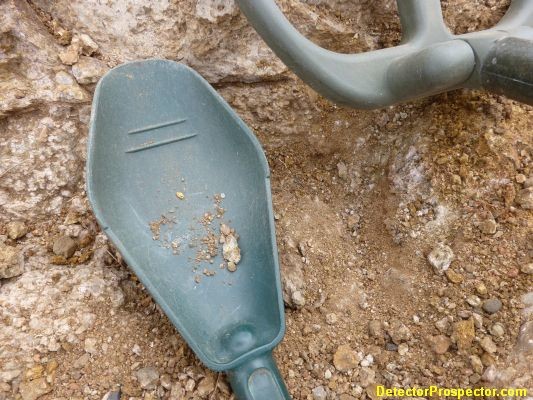
Small 0.16 Gram gold nugget found with Garrett ATX - can you see it?
Frankly, in the United States more often than not it is all about the small gold. Large nuggets are easy to find in many locations, like the area we were hunting. The bedrock is shallow and most of the large nuggets have been found except in rare places a coil has not been over yet. Going deeper will find no more gold since bedrock is so shallow. Small nuggets are hard to detect however and they are also far more plentiful than large nuggets. Many mining districts do not have any large gold at all so you either find the small nuggets or nothing at all. Garrett seems to have realized this and made significant progress in improving the small gold ability of the ATX compared to the now over ten year old Garrett Infinium. Now truthfully, in many locations a good, relatively inexpensive VLF detector is the best choice in the United States when chasing small gold. The problem is areas where there is either ground mineralization or hot rocks or both that seriously impede the ability of VLF detectors to operate efficiently. These are the locations where the ATX will shine.
Luck was with me this day. Again, I worked slowly and carefully up the wash, concentrating on places where I thought bedrock was shallow enough to detect. I got another faint signal from a crevice in exposed bedrock. This one was down in some pretty solid rock so it took a bit of hacking and prying to get it out. Out popped nugget number four, the smallest yet at 1.8 grains or 0.12 grams. One little nugget was maybe a fluke, but now two tiny gold nuggets with the Garrett ATX with stock 12" x 10" DD coil. Definitely impressive.
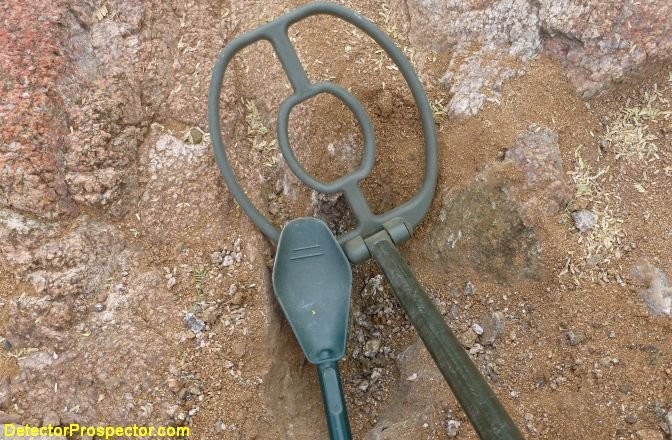
0.12 gram gold nugget found with Garrett ATX metal detector
After two days of nugget detecting I can say without doubt that the new Garrett ATX is a very capable nugget detector. It easily handles ground conditions that most prospectors will encounter in the United States. Most impressive for a pulse induction detector is the small gold sensitivity of the ATX out of the box with the stock coil and no tuning tricks. Basically all I did was bump the gain (sensitivity) up, ground balance, and go. The ATX retains all settings when powered down, so firing up again after a break is no more difficult than turning the detector back on. The waterproof design does add weight, but with the obvious benefits of being able to work in pouring down rain without fear that the detector will be damaged. Even the speaker is fully waterproof. I think the ATX has great potential for working in and around streams and rivers looking for gold lodged in underwater crevices and pockets. I have my suit ready and have the optional underwater headphones required to use the ATX with mask and snorkel. The included headphones allow the detector to be submerged but the actual working ear muff portion of the headset must be kept high and dry.
All in all Garrett has produced a very powerful and very versatile detector at an extremely attractive price. That is a lot of superlatives in one sentence but it is a fact. I have no doubt my ATX will pay for itself in the coming year. My only warning is that this is a professional grade pulse induction metal detector and not for people expecting VLF type discrimination capability. Yet with practice the ATX offers far more than just base level PI discrimination, which is all but non-existent. For basic dig-it-all nugget detecting however, the Garrett ATX is about as simple as it gets. A novice can be up and running in minutes with this detector. The team at Garrett deserves praise for bringing a unique detector to market, expanding the options available for all detectorists.
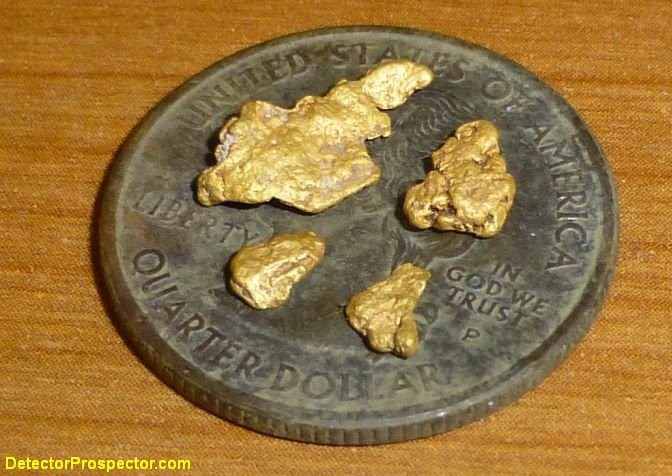
1.36 grams of gold nuggets found with Garrett ATX - smallest 0.12 & 0.16 Grams
Here it is, four gold nuggets found with the new Garrett ATX pulse induction metal detector. Total weight 1.36 grams, smallest nugget 0.12 grams. The dirty quarter found metal detecting is for scale. All found in mineralized ground with the stock 12" x 10" DD coil and no headphones (used built-in speaker). Again, I was impressed by the ability of the ATX straight out of the box to hit gold this small. I can't wait to see what I can do with headphones and the 8" mono coil.
~ Steve Herschbach
Copyright © 2013 Herschbach Enterprises
-
 1
1
-
 2
2



